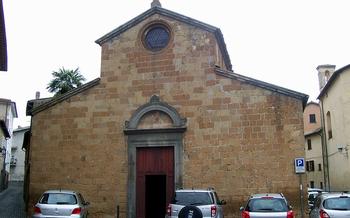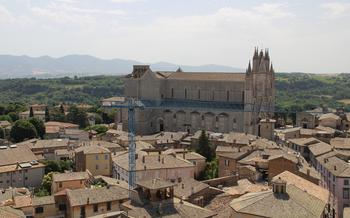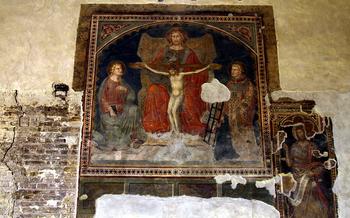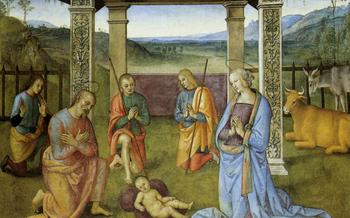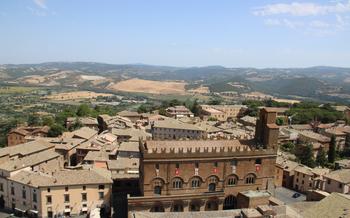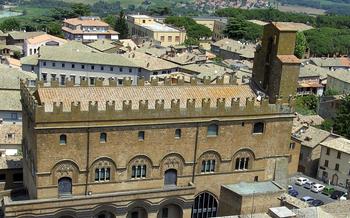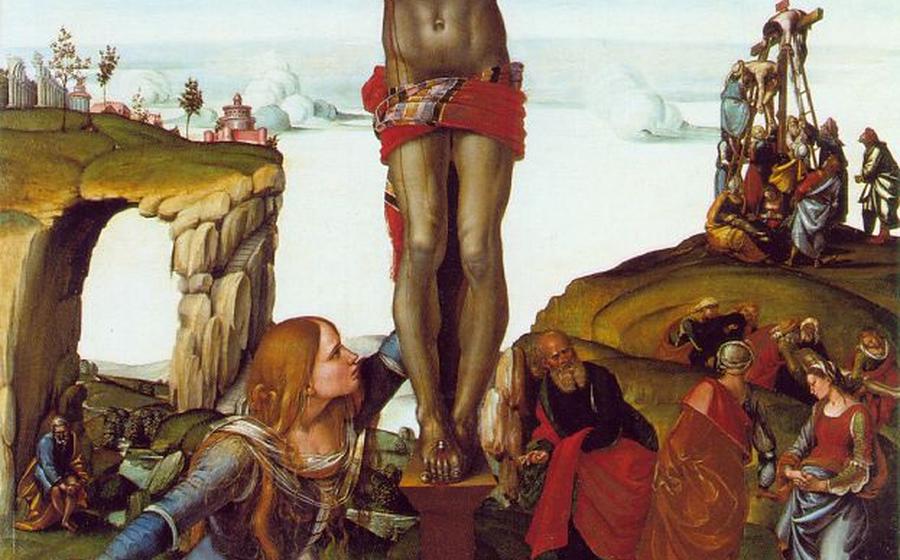
Chiesa di San Leonardo
- Introduction
- History of the Chiesa di San Leonardo
- Exterior of the Church
- Interior of the Church
- The Frescoes by Luca Signorelli
- The Orsini Chapel: A Testament to Renaissance Grandeur
- The Legend of San Leonardo
- Visiting the Chiesa di San Leonardo: Practical Information
- Unveiling the Hidden Crypt
- Unique Artworks in the Church
- Restoration Project of the Chiesa di San Leonardo
- Cultural Events and Festivals
- Pilgrimage Significance of the Church
- Exploring the Surroundings of the Chiesa di San Leonardo
- Insider Tip: Unveiling the Secret Passage
Introduction
Orvieto, an enchanting hilltop city in Umbria, boasts a rich history dating back to the Etruscan era. Among its many architectural gems, the Chiesa di San Leonardo stands out as a testament to the city's enduring devotion and artistic heritage. Situated on the western edge of Orvieto's historic center, the church holds a significant position in the city's religious and cultural fabric. Whether you're a history enthusiast, an art aficionado, or simply seeking a spiritual sanctuary, this remarkable church offers a captivating experience that will leave an unforgettable mark.
History of the Chiesa di San Leonardo
The Chiesa di San Leonardo, a testament to the architectural prowess of the Middle Ages, was constructed during the 11th century, likely between the years 1070 and 1100. Its remarkable design, blending Romanesque and Gothic elements, reflects the transitional period in architectural styles that characterized the era. During medieval times, the church played a prominent role in the religious and cultural life of Orvieto, serving as a hub for spiritual gatherings, artistic commissions, and community events. It continues to hold deep significance for locals and visitors alike, its enduring beauty and historical relevance attracting countless admirers throughout the centuries.
Exterior of the Church
The Chiesa di San Leonardo presents a simple yet elegant facade, featuring a single portal with a Gothic arch and a lunette above it. The lunette contains a beautiful fresco depicting the Madonna and Child with Saints. The facade is further adorned with decorative elements such as pilasters and cornices.
The most striking feature of the church's exterior is its tall and slender bell tower. Rising gracefully above the church, the bell tower boasts a mix of Romanesque and Gothic architectural styles. It features arched windows, decorative friezes, and a crenellated top. The tower offers breathtaking views of the surrounding countryside, making it a popular spot for visitors to capture panoramic shots of Orvieto and the Umbrian landscape.
Other notable artistic elements on the exterior of the church include the intricately carved capitals of the columns that flank the portal and the bas-reliefs depicting scenes from the life of San Leonardo. These sculptures provide a glimpse into the rich iconography and symbolism associated with the saint and his legend.
Interior of the Church
The Chiesa di San Leonardo's interior, despite its modest dimensions, exudes an atmosphere of solemn grandeur. The walls, stripped of excessive ornamentation, reveal the austere simplicity typical of Romanesque architecture. The layout follows a traditional basilical plan, consisting of a single nave leading to a raised sanctuary. The nave is divided into three bays by sturdy pillars, supporting rounded arches that add to the sense of spatial harmony.
The altarpiece, a masterpiece of understated elegance, occupies the central position behind the altar. Crafted from polychrome terracotta, it depicts various scenes from the life of San Leonardo, including his triumph over the dragon. The vibrant hues and intricate details of the terracotta figures bring the biblical narratives to life, creating a captivating visual spectacle.
The church walls are adorned with an array of frescoes and paintings, each contributing to the rich artistic tapestry of the interior. Among the notable works are a series of 14th-century frescoes depicting scenes from the life of Christ and the Virgin Mary. The vibrant colors and expressive figures in these frescoes offer a glimpse into the artistic style and devotional practices of medieval Orvieto.
The Frescoes by Luca Signorelli
The Chiesa di San Leonardo is renowned for its stunning frescoes by the acclaimed Renaissance artist Luca Signorelli. These remarkable artworks, created in the late 15th century, adorn the walls of the church's interior, captivating visitors with their vibrant colors and intricate details. Signorelli's frescoes depict a series of biblical scenes and narratives, including the life of Christ, the Last Judgment, and the legend of San Leonardo.
With his masterful use of perspective and shading, Signorelli brings depth and realism to each scene, inviting viewers to immerse themselves in the biblical stories. The figures portrayed in the frescoes are characterized by their expressive gestures and emotions, reflecting Signorelli's profound understanding of human nature. The vibrant hues and intricate brushwork create a sense of harmony and balance that enhances the overall visual impact of the church's interior.
Signorelli's frescoes not only demonstrate his exceptional artistic talent but also hold deep religious and cultural significance. They served as a visual representation of biblical teachings, educating and inspiring the faithful. The vivid depictions of the saints and their stories provided a tangible connection between the earthly realm and the divine, reinforcing the church's role as a sacred space.
The presence of Signorelli's frescoes in the Chiesa di San Leonardo elevates the church's status as a true artistic treasure. They stand as a testament to the enduring legacy of the Renaissance period and continue to captivate visitors with their beauty, artistry, and spiritual significance.
The Orsini Chapel: A Testament to Renaissance Grandeur
Within the Chiesa di San Leonardo, one's attention is drawn to the opulent Orsini Chapel, a testament to the artistry and power of the Orsini family. Built in the 15th century, the chapel is an architectural masterpiece, designed by the renowned architect Antonio da Sangallo the Younger. Its intricate carvings and delicate frescoes create an atmosphere of awe and splendor.
The chapel boasts an impressive array of artistic treasures that leave visitors spellbound. The altarpiece, a testament to the artistry of Luca Signorelli, depicts stunning scenes from the life of the Virgin Mary. Its vibrant colors and lifelike figures seem to leap off the canvas, capturing the essence of the sacred stories they narrate.
The walls of the chapel are adorned with intricate frescoes by Signorelli and other notable artists of the era. These masterpieces depict biblical scenes, saints, and allegories, narrating tales of faith, redemption, and divine intervention. The vivid colors and expressive brushstrokes create a sense of movement and drama, immersing visitors in the stories they portray.
The Orsini Chapel also houses the impressive tomb of Cardinal Gentile Orsini, a prominent figure in the history of Orvieto. The tomb, crafted from Carrara marble, features intricate carvings and sculptures that depict scenes from the cardinal's life and his devotion to the church.
Visiting the Orsini Chapel is a journey through time, a testament to the artistry, faith, and power that shaped the Renaissance era. This chapel stands as a reminder of the enduring legacy of the Orsini family and their profound impact on the religious and cultural landscape of Orvieto.
The Legend of San Leonardo
The Chiesa di San Leonardo is imbued with the allure of a captivating legend that has shaped its religious and cultural significance. At its heart lies the tale of San Leonardo, a revered figure known for his heroic battle with a ferocious dragon. According to legend, the saint encountered the fearsome creature terrorizing the countryside, relentlessly demanding a human sacrifice. With unwavering bravery, San Leonardo confronted the dragon and emerged victorious, vanquishing the beast and liberating the terror-stricken people.
This legendary encounter holds profound historical and cultural implications. San Leonardo's triumph over the dragon symbolizes the triumph of good over evil, embodying the enduring human spirit's ability to overcome adversity. The legend has deeply resonated with the people of Orvieto, who have revered the saint for centuries and celebrated his heroic act.
San Leonardo's enduring legacy is evident in the iconography adorning the church's interior. In the paintings and sculptures, the saint is often depicted slaying the dragon, a visual testament to his valiant victory. These depictions serve as a constant reminder of the saint's courageous spirit and unwavering faith, inspiring generations of believers to face their own challenges with fortitude.
Visiting the Chiesa di San Leonardo: Practical Information
To fully appreciate the grandeur of the Chiesa di San Leonardo, it is essential to plan your visit carefully.
Unveiling the Hidden Crypt
Concealed beneath the Chiesa di San Leonardo lies a captivating crypt, whispering tales of a bygone era. Descend the stone steps, and you will be transported to a subterranean realm steeped in history and intrigue. Constructed during the medieval period, the crypt served as a sacred burial ground for the noble Orsini family, who played a pivotal role in Orvieto's governance.
The sturdy walls of the crypt emanate an aura of timelessness, adorned with intricate frescoes that narrate biblical tales and depict scenes of saints and martyrs. Each fresco tells a story, inviting you to delve into the rich tapestry of Orvieto's past. The dimly lit chamber evokes a sense of mystery and reverence, as if whispering secrets from the depths of the earth.
In the heart of the crypt lies a remarkable discovery: an ancient well, its waters once believed to possess miraculous healing powers. Pilgrims from far and wide flocked to the crypt, seeking solace and redemption through the well's sacred waters. As you gaze upon this well, you can almost hear the echoes of prayers and supplications that have resonated within these hallowed walls for centuries.
During excavations in the crypt, archaeologists stumbled upon a treasure trove of artifacts, including ceramic fragments, bronze objects, and human remains. These discoveries provide valuable insights into the daily lives and funerary practices of medieval Orvieto's elite. The crypt stands as a testament to the enduring legacy of the Orsini family, perpetuating their influence and devotion even beyond their earthly existence.
Unique Artworks in the Church
Apart from the renowned frescoes by Luca Signorelli, the Chiesa di San Leonardo boasts a treasure trove of other remarkable artworks that captivate visitors with their intricate details and profound symbolism. One such masterpiece is the Polyptych of San Leonardo, an exquisite altarpiece attributed to the Sienese artist Ugolino di Nerio. Crafted in the 14th century, this stunning altarpiece features a central panel depicting the enthroned Madonna and Child flanked by eight smaller panels portraying scenes from the life of San Leonardo. Each panel exudes a serene elegance, showcasing the artist's mastery of color and composition.
Another highlight is the Carved Wooden Choir Stalls, which line the walls of the chancel. Created by the skilled hands of local artisans in the 15th century, these intricate carvings depict a variety of biblical scenes, mythological creatures, and everyday life vignettes. The stalls are a testament to the exceptional craftsmanship and artistry of the period, offering a glimpse into the minds and imaginations of medieval artisans.
The church also houses several noteworthy frescoes and paintings by lesser-known but equally talented artists. The "Crucifixion" by Andrea di Giovanni, located in the left transept, is a poignant portrayal of Christ's suffering, capturing the profound emotions of the scene with remarkable realism. "The Adoration of the Magi" by Antonio del Massaro, situated in the right transept, showcases the artist's vibrant color palette and intricate attention to detail.
These artworks, along with numerous other hidden gems within the Chiesa di San Leonardo, contribute to its rich artistic heritage and offer visitors a captivating journey through the history of medieval and Renaissance art.
Restoration Project of the Chiesa di San Leonardo
The Chiesa di San Leonardo has undergone several restoration projects over the centuries to preserve its historical integrity and artistic splendor. One of the most significant restorations was conducted in the late 19th and early 20th centuries, led by renowned architect and restorer Gustavo Giovannoni. Giovannoni's meticulous work focused on restoring the church's original features and removing alterations made during previous renovations.
The restoration project involved careful cleaning and restoration of the frescoes, particularly those by Luca Signorelli, which had suffered from centuries of neglect and damage. The team also addressed structural issues such as reinforcing the foundations and repairing the roof to ensure the church's stability.
The restoration efforts paid off, as the Chiesa di San Leonardo regained its former glory and became a testament to the enduring beauty of medieval architecture and art. Today, visitors can admire the church's well-preserved frescoes and sculptures, which have been meticulously restored to their original vibrancy.
The restoration not only preserved the church's historical and artistic heritage but also enhanced the appreciation of its unique features and the artistry of its creators. Visitors can now fully immerse themselves in the beauty and significance of this remarkable church, thanks to the dedication and expertise of the restoration team.
Cultural Events and Festivals
The Chiesa di San Leonardo is not only a place of worship but also a vibrant cultural hub that hosts a variety of events and festivals throughout the year. These festivities provide an opportunity for visitors to immerse themselves in the local culture and traditions while celebrating the church's rich heritage.
One of the most renowned events is the annual Feast of San Leonardo, celebrated on November 6th. This religious festival honors the patron saint of Orvieto with processions, masses, and traditional dances. The streets surrounding the church come alive with music, food stalls, and lively performances, creating a festive atmosphere that attracts locals and tourists alike.
Another highlight is the Orvieto Music Festival, held every summer. This renowned festival showcases a diverse range of musical genres, from classical to jazz and contemporary, featuring performances by acclaimed musicians from around the world. The concerts take place in the church's atmospheric interior, creating an unforgettable acoustic experience.
Art enthusiasts will delight in the Orvieto Arte Festival, which brings together local and international artists to exhibit their works in various locations around the city, including the Chiesa di San Leonardo. This vibrant festival showcases a variety of artistic expressions, from paintings and sculptures to photography and installations, offering visitors a unique opportunity to appreciate the region's rich artistic heritage.
Pilgrimage Significance of the Church
The Chiesa di San Leonardo has long held religious significance as a pilgrimage site, attracting devout believers from near and far. During medieval times, Orvieto served as a vital stop on the Via Francigena, a prominent pilgrimage route connecting Canterbury in England to Rome. Pilgrims journeying along this sacred path would often seek solace and spiritual guidance within the church's hallowed walls, praying to San Leonardo for protection and guidance on their arduous journeys.
The church's association with San Leonardo, a revered saint known for his miraculous deeds and his patronage of prisoners and captives, further enhances its allure as a pilgrimage destination. Pilgrims from all walks of life, seeking divine intervention, healing, or simply a moment of respite, have flocked to the church for centuries.
The tradition of pilgrimage continues to thrive in modern times, with countless pilgrims visiting the Chiesa di San Leonardo each year to pay homage to San Leonardo and to seek solace and spiritual renewal within its sacred space. For those seeking a deeper connection with their faith, the church offers a powerful and moving experience, inviting reflection, introspection, and a profound sense of peace.
Exploring the Surroundings of the Chiesa di San Leonardo
Beyond the church's walls, Orvieto unfolds a tapestry of enchanting landmarks that beckon exploration. A short stroll from the church, the majestic Piazza del Duomo captivates with its stunning cathedral, a testament to Gothic architecture. Its intricate facade, adorned with biblical scenes and mythical creatures, is a masterpiece that leaves visitors in awe.
History buffs can delve into the depths of Orvieto's storied past at the Museo Archeologico Nazionale. This treasure trove of Etruscan and Roman artifacts offers a glimpse into the region's ancient civilizations. The museum's collection of bronze statues, pottery, and sarcophagi unveils the rich cultural heritage that has shaped Orvieto over the centuries.
For a panoramic vista that takes the breath away, ascend to the Torre del Moro, a medieval tower that stands sentinel over the city. From its lofty heights, the entire Umbrian countryside unfolds, with rolling hills, verdant valleys, and picturesque villages dotting the landscape.
Nature enthusiasts will find solace in the Parco Archeologico di Orvieto, a sprawling expanse of lush vegetation and historical ruins. This enchanting park offers a tranquil retreat, where visitors can wander amidst ancient Etruscan tombs and admire the beauty of nature's embrace.
Craft and culinary enthusiasts alike will delight in exploring the Orvieto Underground, a network of caves and tunnels that once served as workshops and storage spaces. Today, these subterranean chambers house artisan shops, where visitors can witness the creation of exquisite ceramics, jewelry, and leather goods.
A visit to the Chiesa di San Leonardo provides an immersive experience that extends beyond the church's sacred walls. By venturing into the surrounding area, travelers discover a captivating blend of history, art, and nature, making Orvieto a destination that promises an unforgettable journey.
Insider Tip: Unveiling the Secret Passage
Beyond its visible wonders, the Chiesa di San Leonardo holds a captivating secret—the whispered legend of a hidden passage. While its existence remains shrouded in mystery, some claim it leads to an underground tunnel connecting the church to other significant sites in Orvieto. Though its authenticity is uncertain, the allure of this tale adds an enigmatic charm to the church.
If you're intrigued by the prospect of exploring this hidden passage, remember to approach the staff with respect and curiosity. While they may not be able to provide definite answers, their knowledge and stories might offer valuable insights into the church's concealed secrets. Unveiling this passage is not just about discovering a hidden path but about connecting with the rich history and folklore that make the Chiesa di San Leonardo so captivating.

